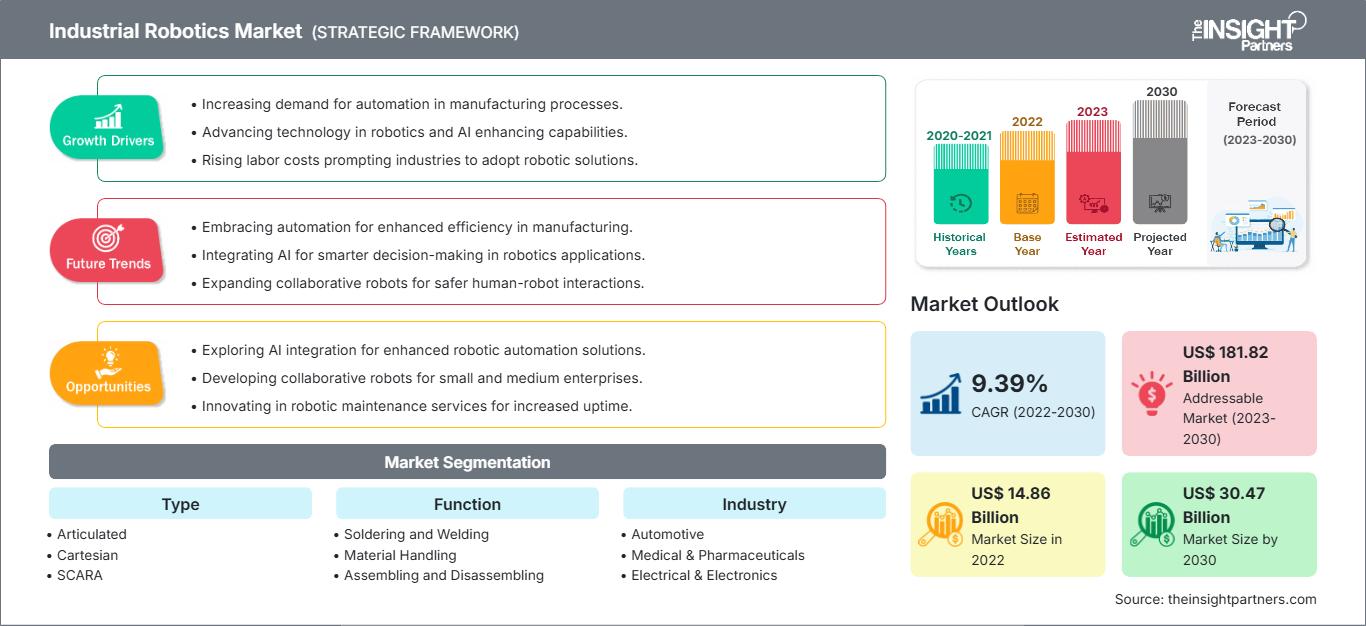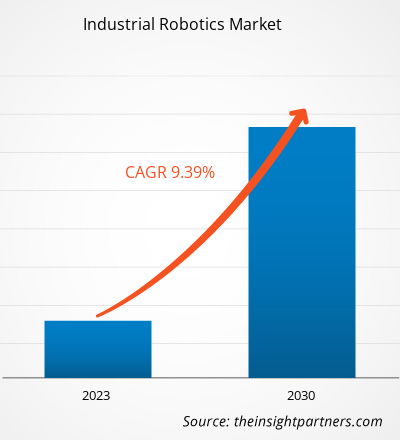预计到 2030 年,工业机器人市场规模将从 2022 年的 148.6 亿美元增至 304.7 亿美元。预计该市场在 2022 年至 2030 年期间的复合年增长率为 9.39%。对 5G 技术和边缘计算的不断增长的需求可能仍将是市场的主要趋势。
工业机器人市场分析
工业 4.0 概念的发展和对用于提高运营效率的协作机器人日益增长的需求正在推动市场的发展。由于制造业、仓库和物流行业对自动化的需求不断增长,预计市场在预测期内将会增长。此外,人工智能技术与机器人技术的融合也为市场创造了丰厚的利润。
工业机器人市场概览
工业机器人可以定义为配备传感器和控制器的机械臂,可以在工业产品的生产中执行各种功能和操作。它们被编程为周期性地执行重复性任务。这些机器人大幅减少了生产中涉及的人力因素,同时提高了加工速度、质量和产能。机器人最重要的部件无疑是由关节和连接件组成的机械臂。机械臂末端工具 (EOAT) 是机械臂最关键的部件。它们可以执行各种任务,包括标记、切割、焊接、钻孔、喷漆和清洁。
自定义此报告以满足您的要求
您将免费获得任何报告的定制,包括本报告的部分内容,或国家级分析、Excel 数据包,以及为初创企业和大学提供超值优惠和折扣
工业机器人市场: 战略洞察

- 获取本报告的主要市场趋势。这个免费样本将包括数据分析,从市场趋势到估计和预测。
工业机器人市场驱动力和机遇工业 4.0 概念的演变有利于市场工业 4.0 代表着制造业和工业格局的持续转型,其特点是机器人、自动化、人工智能 (AI) 和物联网 (IoT) 等先进技术的融合。第四次工业革命标志着从传统自动化向智能互联系统的转变,可实现数据驱动的决策和实时流程优化。工业 4.0 框架下最重要的发展之一是将工业物联网 (IIoT) 和人工智能集成到机器人系统中。这些技术正在推动自主协作机器人 (cobot) 的出现,这些机器人能够独立操作、与人类工人安全交互并适应动态生产环境。与早期机器人仅限于执行固定重复性任务不同,现代机器人系统高度灵活,能够快速响应运营条件的变化。
您将免费获得任何报告的定制,包括本报告的部分内容,或国家级分析、Excel 数据包,以及为初创企业和大学提供超值优惠和折扣
工业机器人市场: 战略洞察

- 获取本报告的主要市场趋势。这个免费样本将包括数据分析,从市场趋势到估计和预测。
工业 4.0 推动创新维护策略,尤其是预测性维护和基于状态的维护,这些策略依赖于实时数据分析和机器学习。这些方法可以最大限度地减少计划外停机时间,优化资产利用率,降低维护成本,从而显著提高运营效率。这些进步预计将加速机器人技术在汽车、电子、物流和制药等各行各业的应用。将以前手动的劳动密集型任务自动化,不仅可以提高生产力,还可以应对劳动力短缺和工资压力上升等日益严峻的挑战。
此外,智能机器人系统的部署正在增强机器管理和生产可视性,使企业能够更迅速地响应需求波动和生产异常。随着制造商持续投资数字化转型,预计未来几年对智能机器人解决方案的需求将大幅增长。通过利用互联互通、人工智能和自动化的力量,企业有望在日益数字化的经济中实现更高的敏捷性、效率和竞争力。因此,工业4.0的发展正在重新定义机器人在工业环境中的角色,进而推动工业机器人市场的发展。
人工智能技术与机器人技术的融合
人工智能正在推动机器人和自动化领域的显著进步。随着机器人领域人工智能的不断发展和蓬勃发展,众多行业正在利用这些尖端技术,例如实施智能自动化流程来支持复杂的数据收集和分析,使企业、服务机构和制造商能够做出数据驱动的决策,或部署具有自学习能力的机器人来简化工作流程和任务。预计在预测期内,基于人工智能的自学习机器人的采用将为市场创造机会。工业机器人市场报告细分分析
促成工业机器人市场分析的关键细分是类型、功能和行业。- 根据类型,工业机器人市场分为铰接式、笛卡尔式、SCARA式、协作式、并联式和其他类型。铰接式机器人在 2022 年占据了最大的市场份额。
- 根据功能,市场细分为焊接、物料搬运、组装和拆卸、喷漆和分配、铣削以及切割和加工。物料搬运部分在 2022 年占据了最大的市场份额。
- 就行业而言,市场分为汽车、医疗和制药、电气和电子、橡胶和塑料、金属和机械以及食品和农业。食品和2022 年,农业领域占据了最大的市场份额。
按地区划分的工业机器人市场份额分析
工业机器人市场报告的地理范围主要分为五个地区:北美、亚太地区、欧洲、中东和非洲以及南美和中美洲。由于对工业机器人的需求不断增长,预计欧洲市场在预测期内将扩大。与 2020 年相比,2021 年工业机器人安装量增长了 33%。与 2020 年相比,2021 年,电子行业的工业机器人使用量增长了 22%,汽车行业的工业机器人使用量增长了 57%,金属和机械行业的工业机器人使用量增长了 29%。根据 IFR 的数据,2023 年 1 月,中国、日本和韩国位列工业机器人年度安装量最先进的五个国家之列,其中中国工业机器人市场发展最快。
工业机器人市场区域洞察
The Insight Partners 的分析师已详尽阐述了预测期内影响工业机器人市场的区域趋势和因素。本节还讨论了北美、欧洲、亚太地区、中东和非洲以及南美和中美洲的工业机器人市场细分和地域分布。
工业机器人市场报告范围
| 报告属性 | 细节 |
|---|---|
| 市场规模 2022 | US$ 14.86 Billion |
| 市场规模 2030 | US$ 30.47 Billion |
| 全球复合年增长率 (2022 - 2030) | 9.39% |
| 历史数据 | 2020-2021 |
| 预测期 | 2023-2030 |
| 涵盖的领域 |
By 类型
|
| 覆盖地区和国家 | 北美
|
| 市场领导者和主要公司简介 |
|
工业机器人市场参与者密度:了解其对商业动态的影响
工业机器人市场正在快速增长,这得益于终端用户需求的不断增长,而这些需求的驱动因素包括消费者偏好的不断变化、技术进步以及对产品优势的认知度不断提高。随着需求的增长,企业正在扩展其产品线,不断创新以满足消费者需求,并抓住新兴趋势,从而进一步推动市场增长。

- 获取 工业机器人市场 主要参与者概述
- ABB 有限公司重申了对其最重要的客户市场之一——美国的承诺,开始扩建其位于密歇根州奥本山的现有机器人总部和生产工厂。该项目将于 2023 年 11 月完工,预计耗资 2000 万美元。此次扩建将在该地区创造 72 个新的高技能工作岗位,并由密歇根州商业发展计划提供的 45 万美元绩效补助金提供支持。 (来源:ABB Ltd,公司网站,2023 年 3 月)
工业机器人市场报告覆盖范围和交付成果
“工业机器人市场规模和预测(2020 年–2030 年)”报告对市场进行了详细的分析,涵盖以下领域:- 工业机器人市场规模以及涵盖范围内所有主要细分市场的全球、区域和国家/地区预测
- 工业机器人市场趋势以及市场动态,例如驱动因素、限制因素和关键机遇
- 详细的 PEST/波特五力模型和 SWOT 分析
- 工业机器人市场分析,涵盖主要市场趋势、全球和区域框架、主要参与者、法规和最新市场发展
- 行业格局和竞争分析,涵盖市场集中度、热图分析、知名参与者和工业机器人市场的最新发展
- 详细的公司简介
- 历史分析(2 年)、基准年、预测(7 年)及复合年增长率
- PEST和SWOT分析
- 市场规模、价值/数量 - 全球、区域、国家
- 行业和竞争格局
- Excel 数据集
近期报告
客户评价
购买理由
- 明智的决策
- 了解市场动态
- 竞争分析
- 客户洞察
- 市场预测
- 风险规避
- 战略规划
- 投资论证
- 识别新兴市场
- 优化营销策略
- 提升运营效率
- 顺应监管趋势




















 获取免费样品 - 工业机器人市场
获取免费样品 - 工业机器人市场